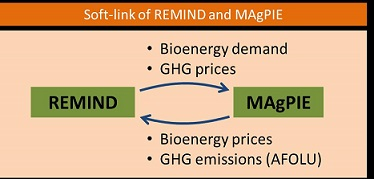Land-use - REMIND-MAgPIE
| Corresponding documentation | |
|---|---|
| Previous versions | |
| Model information | |
| Model link | |
| Institution | Potsdam Institut für Klimafolgenforschung (PIK), Germany, https://www.pik-potsdam.de. |
| Solution concept | General equilibrium (closed economy)MAgPIE: partial equilibrium model of the agricultural sector; |
| Solution method | OptimizationMAgPIE: cost minimization; |
| Anticipation | |
Note: This pages describes the REMIND 1.7 model. It will be updated shortly to describe the most recent version of REMIND-MAgPIE.
There are a number of important interactions of the energy, economy and climate systems represented in REMIND-MAgPIE with the land system, such as emissions from land use changes and agriculture, or bioenergy supply. In the default standalone mode, REMIND-MAgPIE relies on reduced-form approaches to account for these inter-linkages between the energy and the agricultural and land-use sectors (stand-alone mode). These are derived based on the state-of-the-art land use model MAgPIE [1]; [2]; [3]. For a detailed and fully consistent analysis of the integrated energy-economy-land use system, REMIND-MAgPIE can also be soft-linked and run iteratively with MAgPIE as depicted in Figure 7 (coupled mode). The soft-link between REMIND-MAgPIE and MAgPIE focuses on two crucial interactions: (i) bioenergy demand and supply, (ii) land use/land use change emissions and GHG prices. At the end-point of the iterative solution process, the markets for bioenergy and emission mitigation across the energy and land-use sector are in equilibrium.
<figure id="fig:REMIND-MAgPIE_7">
 </figure>
</figure>
Figure 1. In the coupled mode REMIND-MAgPIE is soft-linked to the land-use model MAgPIE. The models are run iteratively and exchange information about bioenergy demand and supply and about emission mitigation in the land-use system.
- ↑ Lotze-Campen H, Müller C, Bondeau A, et al (2008) Global food demand, productivity growth, and the scarcity of land and water resources: a spatially explicit mathematical programming approach. Agricultural Economics 39:325–338. doi: 10.1111/j.1574-0862.2008.00336.x
- ↑ Popp A, Lotze-Campen H, Bodirsky B (2010) Food consumption, diet shifts and associated non-CO2 greenhouse gases from agricultural production. Global Environmental Change 20:451–462. doi: 10.1016/j.gloenvcha.2010.02.001
- ↑ Lotze-Campen H, Popp A, Beringer T, et al (2010) Scenarios of global bioenergy production: The trade-offs between agricultural expansion, intensification and trade. Ecological Modelling 221:2188–2196. doi: 10.1016/j.ecolmodel.2009.10.002